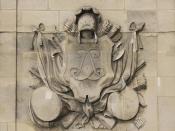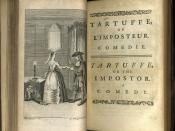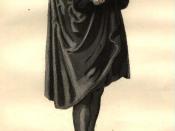John Machiorlatti and Amanda Chartier Review of ?Tartuffe? Theatre 402 October 30, 2001 The Face of Virtue/The Face of Evil: Tartuffe Brings Laughter and a Lesson to the Power Center Friday evening?s performance of Moliére?s Tartuffe, presented by Minneapolis?s Theatre de la Jeune Lune company, was a thoroughly entertaining display of Renaissance-period drama incorporating modern theatrical practices to create a wonderfully contemporary rendering of a classic story.
Tartuffe was first performed in a private production for King Louis XIV of France on May 12th, 1664, at Versailles. In a fair warning to the king and a plea for support, Moliére wrote, ?[Other] comedies attack piety and religion itself, which [the people] do not care much for. But this one, Tartuffe, attacks them, and shows them for what they are. And that, they cannot stand. They will never forgive me.? Indeed, although the play pleased the king immensely, it was banned from public performance because of strong objections from officials of the Catholic church, led by the Company of the Holy Sacrament.
Moliére at first protested, then revised the play, and in 1667 he was permitted to produce it for a second time in front of the king and his court. Again it was banned. Finally, after Moliére's third petition to the king, the ban was lifted in 1669 and the play was performed for the public. It was an instant success, and it is this third version of the play that was published, protected from censorship, and is now performed all over the world.
Moliére?s comedies are usually more light-hearted than the comical yet uncomfortably sinister Tartuffe. Born as Jean-Baptiste Poquelin in 1622, he took the stage name ?Moliére? at the age of twenty-one and began to write farces modeled after Italian commedia dell?arte, which was very active in Paris.


